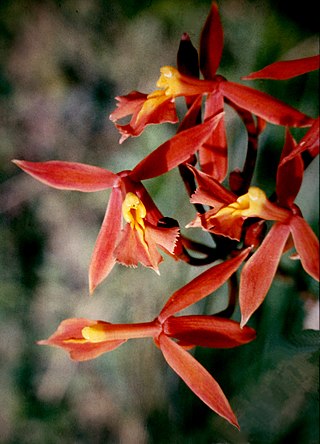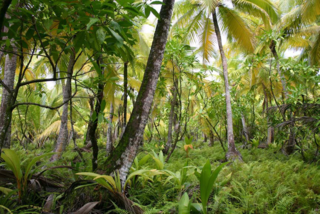
Spanish moss is an epiphytic flowering plant that often grows upon large trees in tropical and subtropical climates. It is native to much of Mexico, Bermuda, the Bahamas, Central America, South America, the Southern United States, and West Indies. It has been naturalized in Queensland (Australia). It is known as "grandpa's beard" in French Polynesia. It has the widest distribution of any bromeliad.

Tillandsia is a genus of around 650 species of evergreen, perennial flowering plants in the family Bromeliaceae, native to the forests, mountains and deserts of the Neotropics, from northern Mexico and the southeastern United States to Mesoamerica and the Caribbean to central Argentina. Their leaves, more or less silvery in color, are covered with specialized cells (trichomes) capable of rapidly absorbing water that gathers on them.

A lichen is a hybrid colony of algae or cyanobacteria living symbiotically among filaments of multiple fungi species, along with yeasts and bacteria embedded in the cortex or "skin", in a mutualistic relationship. Lichens are the lifeform that first brought the term symbiosis under biological context.

Pioneer species are resilient species that are the first to colonize barren environments, or to repopulate disrupted biodiverse steady-state ecosystems as part of ecological succession. A number of kinds of events can create good conditions for pioneers, including disruption by natural disasters, such as wildfire, flood, mudslide, lava flow or a climate-related extinction event or by anthropogenic habitat destruction, such as through land clearance for agriculture or construction or industrial damage. Pioneer species play an important role in creating soil in primary succession, and stabilizing soil and nutrients in secondary succession.

Non-vascular plants are plants without a vascular system consisting of xylem and phloem. Instead, they may possess simpler tissues that have specialized functions for the internal transport of water.

The Tasmanian temperate rain forests are a temperate broadleaf and mixed forests ecoregion in western Tasmania. The ecoregion is part of the Australasian realm, which includes Tasmania and Australia, New Zealand, New Guinea, New Caledonia, and adjacent islands.

Lithophytes are plants that grow in or on rocks. They can be classified as either epilithic or endolithic; epilithic lithophytes grow on the surfaces of rocks, while endolithic lithophytes grow in the crevices of rocks. Lithophytes can also be classified as being either obligate or facultative. Obligate lithophytes grow solely on rocks, while facultative lithophytes will grow partially on a rock and on another substrate simultaneously.

Epidendroideae is a subfamily of plants in the orchid family, Orchidaceae. Epidendroideae is larger than all the other orchid subfamilies together, comprising more than 15,000 species in 576 genera. Most epidendroid orchids are tropical epiphytes, typically with pseudobulbs. There are, however, some terrestrials such as Epipactis and even a few myco-heterotrophs, which are parasitic upon mycorrhizal fungi.

Primary succession is the beginning step of ecological succession where species known as pioneer species colonize an uninhabited site, which usually occurs in an environment devoid of vegetation and other organisms.

Catopsis berteroniana, commonly known as the powdery strap airplant or the lantern of the forest, is an epiphytic bromeliad thought to be a possible carnivorous plant, similar to Brocchinia reducta, although the evidence is equivocal. Its native range is from southern Florida to southern Brazil. It generally grows on the unshaded twigs of trees, and has been shown experimentally to trap more insects in its tank than other bromeliads of comparable size. There are several other species in the genus, none of which is believed to be carnivorous.
An aquatic ecosystem is an ecosystem found in and around a body of water, in contrast to land-based terrestrial ecosystems. Aquatic ecosystems contain communities of organisms—aquatic life—that are dependent on each other and on their environment. The two main types of aquatic ecosystems are marine ecosystems and freshwater ecosystems. Freshwater ecosystems may be lentic ; lotic ; and wetlands.

Biological soil crusts, often abbreviated as biocrusts, are communities of living organisms inhabiting the surface of soils in arid and semi-arid ecosystems, which form stable aggregates of soil particles in a thin layer millimeters to centimeters thick. They are found throughout the world with varying species composition and cover depending on topography, soil characteristics, climate, plant community, microhabitats, and disturbance regimes. An estimated 12% of Earth's surface is covered by biocrusts.

Forest ecology is the scientific study of the interrelated patterns, processes, flora, fauna, funga, and ecosystems in forests. The management of forests is known as forestry, silviculture, and forest management. A forest ecosystem is a natural woodland unit consisting of all plants, animals, and micro-organisms in that area functioning together with all of the non-living physical (abiotic) factors of the environment.
Ecological facilitation or probiosis describes species interactions that benefit at least one of the participants and cause harm to neither. Facilitations can be categorized as mutualisms, in which both species benefit, or commensalisms, in which one species benefits and the other is unaffected. This article addresses both the mechanisms of facilitation and the increasing information available concerning the impacts of facilitation on community ecology.

The flora of Australia comprises a vast assemblage of plant species estimated to over 21,000 vascular and 14,000 non-vascular plants, 250,000 species of fungi and over 3,000 lichens. The flora has strong affinities with the flora of Gondwana, and below the family level has a highly endemic angiosperm flora whose diversity was shaped by the effects of continental drift and climate change since the Cretaceous. Prominent features of the Australian flora are adaptations to aridity and fire which include scleromorphy and serotiny. These adaptations are common in species from the large and well-known families Proteaceae (Banksia), Myrtaceae, and Fabaceae.

Plant ecology is a subdiscipline of ecology that studies the distribution and abundance of plants, the effects of environmental factors upon the abundance of plants, and the interactions among plants and between plants and other organisms. Examples of these are the distribution of temperate deciduous forests in North America, the effects of drought or flooding upon plant survival, and competition among desert plants for water, or effects of herds of grazing animals upon the composition of grasslands.

Niphidium crassifolium, commonly known as the graceful fern, is a species of fern in the family Polypodiaceae found in Central and South America. It is predominantly epiphytic, growing on other plants—for example, in the canopies of trees—but occasionally grows on rocks or on the ground, particularly at higher altitude. It has a rhizome from which many fine rootlets covered in dark reddish-brown scales grow. Together they form a root basket that, when growing on trees, helps to trap leaf litter and dust, forming a nutrient-rich soil that holds water. Its leaves are simple in shape, 13–85 centimetres (5–33 in) long and 3–5 centimetres (1.2–2.0 in) wide and when dry, and covered by a wax-like film. The sori are round and large, occurring in single rows between veins at the far end of the leaf.
Canopy soils, also known as arboreal soils, exist in areas of the forest canopy where branches, crevices, or some other physical feature on a tree can accumulate organic matter, such as leaves or fine branches. Eventually, this organic matter weathers into some semblance of a soil, and can reach depths of 30 cm in some temperate rainforests. Epiphytes can take root in this thin soil, which accelerates the development of the soil by adding organic material and physically breaking up material with their root system. Common epiphytes in the canopy soils in temperate rainforests include mosses, ferns, and lichens. Epiphytes on trees in the temperate zone are often ubiquitous and can cover entire trees. Some host trees house up to 6.5 tons dry weight of epiphytic biomass, which can equate to more than 4x of its own foliar mass. This massive presence means their dynamics need to be better understood in order to fully understand forest dynamics. The nutrients that become stored within canopy soils can then be utilized by the epiphytes that grow in them, and even the tree that the canopy soil is accumulating in through the growth of canopy roots. This storage allows nutrients to be more closely cycled through an ecosystem, and prevents nutrients from being washed out of the system.

Antitrichia curtipendula is a species of feather-moss found predominantly in western North America and the western coast of Europe.

Drymoanthus adversus is an orchid species endemic to New Zealand.
























